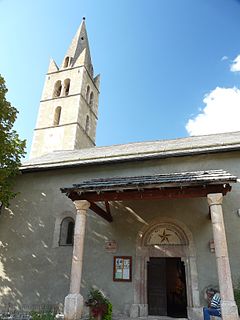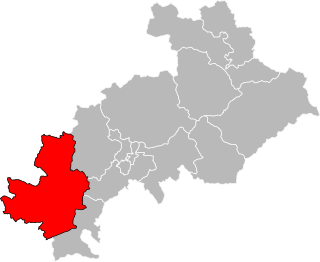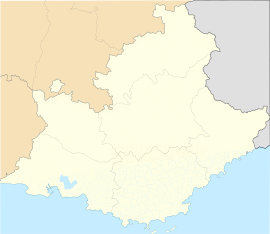Saix, Saïx or SAIX may refer to:

Samoëns is a commune in the Haute-Savoie department in the Auvergne-Rhône-Alpes region in south-eastern France. It is the principal commune for the canton which bears its name. The town of Samoëns is located in the Vallée du Giffre in the French Alps.

Lullin is a commune in the Haute-Savoie department in the Auvergne-Rhône-Alpes region in south-eastern France. It borders the communes of Vailly, Orcier, Habère-Poche and Bellevaux. The river Follaz goes through the town before flowing into the river Brevon, which in turn flows into the river Dranse, which eventually flows into Lake Geneva . The commune of Lullin includes several hamlets such as Pimberty, La Siaux, la Touvière, La Grange des Bois, Le Feu, Très-le-Mont, Chez Dagain, Vauverdanne, Monterrebout, Les Courbes, Les Granges, Recueillères. Its highest point is Mont Forchat (1545m).

Verchaix is a commune in the Haute-Savoie department in the Auvergne-Rhône-Alpes region in south-eastern France.

Aubenas-les-Alpes is a commune in the Alpes-de-Haute-Provence department in the Provence-Alpes-Côte d'Azur region of south-eastern France.

Beynes is a commune in the Alpes-de-Haute-Provence department in southeastern France.

Blieux is a commune in the Alpes-de-Haute-Provence department in southeastern France.

Céreste is a commune in the Alpes-de-Haute-Provence department in southeastern France. It is known for its rich fossil beds in fine layers of "Calcaire de Campagne Calavon" limestone, which are now protected by the Parc naturel régional du Luberon and the Réserve naturelle géologique du Luberon.

Clamensane is a commune in the Alpes-de-Haute-Provence department in southeastern France.

Entrages is a commune in the Alpes-de-Haute-Provence department in southeastern France.

Quinson is a commune in the Alpes-de-Haute-Provence department in southeastern France.

Saint-Lions is a commune in the Alpes-de-Haute-Provence department in southeastern France.

Le Castellet is a commune in the Alpes-de-Haute-Provence department in southeastern France.

Le Vernet is a commune in the Alpes-de-Haute-Provence department, and in the region of Provence-Alpes-Côte d'Azur, in southeastern France.

Le Noyer is a commune in the Hautes-Alpes department in southeastern France. With its neighbouring hamlets of Le Serre, Le Martouret and Le Villard, it lies on the banks of the river Drac, close to the Écrins National Park.

Eygliers is a commune in the Hautes-Alpes department in southeastern France.

Barret-sur-Méouge is a commune in the Hautes-Alpes department in southeastern France. It is located at the start of the 'Gorges de la Méouge' on the Méouge river.

Villaz is a commune in the Haute-Savoie department in the Auvergne-Rhône-Alpes region in south-eastern France.

Habère-Lullin is a commune in the Haute-Savoie department in the Auvergne-Rhône-Alpes region in south-eastern France. It lies on the river Menoge, in the Vallée Verte.

The canton of Serres is an administrative division in southeastern France. At the French canton reorganisation which came into effect in March 2015, the canton was expanded from 12 to 41 communes :






















